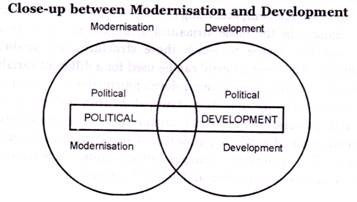ADVERTISEMENTS:
It is still more difficult to distinguish political modernisation and political development. Much is common to both within interlocked processes, as given in the following diagram of modernisation and development.
The concept of ‘political modernisation’ is less vague, more open-ended, and includes notion of development. On the basis of Lucian Pye’s syndrome and others, political modernisation can be explained as political transformation undergone in Europe.
It can be related to four processes:
(i) A general attitude towards equality which allows equality of opportunity to participate in politics and compete for official positions;
(ii) The capacity of a political system to formulate policies and to have them carried out;
(iii) Differentiation and specialisation of political functions though not at the expense of overall integration; and
(iv) The secularisation of the political process – separation of politics from religious aims, goals, and influences.
ADVERTISEMENTS:
Packenham relates it to rationalisation, participation, and integration. Problems coming out of political modernisation, have to be solved. At this stage, political development comes to our rescue. It is the political system’s capacity to solve these problems. The essence of political development is the capacity for or capability to solve developmental problems.
According to Almond and Powell, political development takes place if a political system successfully copes with the challenge of developmental problems of the state and nation-building, distribution, and the like. Its significance lies, in general, to increase effectiveness and efficiency of the performance of the political system, and also its capabilities.
A system, according to them, must have adequate sources of extraction and regulation before it can begin to distribute resources: structures first must be differentiated and specialised. Diamant conceives political development as a process, which aims at a particular condition, specially the one which creates an institutional framework for solving an ever-widening range of social problems.”
It is quite clear that both embrace one or more notions involving political change, and use them to explain either of the two concepts.
ADVERTISEMENTS:
They discuss:
(1) Political changes necessary for the achievement of a specific objective, such as liberal democracy in USA or Great Britain.
(2) A general process of change in the political sphere, closely related to other areas of society, supposed to comprise:
(a) The expansion and centralisation of governmental power, and the differentiation and specialisation (and subsequent integration); of political functions and structures;
(b) Increased popular participation in politics; and
ADVERTISEMENTS:
(c) Increased popular identification with the political system.
(3) The political system’s capacity (a) to solve problems, developmental and others and (b) to initiate (and sustain) new policies for the society in which it operates, and to set up new structures or reform older ones, to carry out such aims.
(4) The ability to learn better and how to perform political functions and to set up political structures.
Political modernisation mostly refers to processes mentioned in (2) above, while political development includes, (1), (3) and (4). From this point of view, India in 1980s could be said to have, in a rough manner, political development (infrastructure and capability), but not political modernisation (deeper, inner, and wider commitment to politics). Political modernisation is a process within it may not come out in structural forms, and vice versa.
There can, thus, be political development, owing to borrowings, historical legacies and adaptation of political technologies, in a country without political modernisation, and the latter without flowering itself into infrastructures of political development. There can, thus, be to some extent political development without political modernisation, and political modernisation may remain unable to fructify itself into political development, when both concepts are used in a specific sense.
